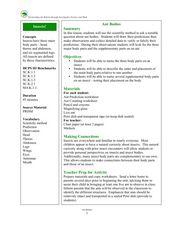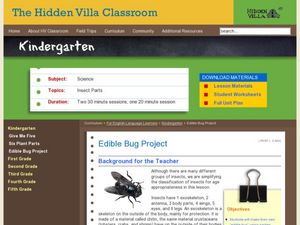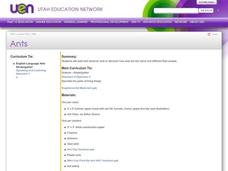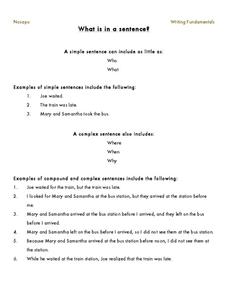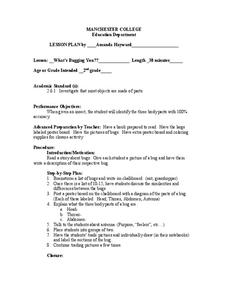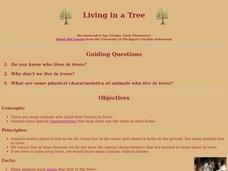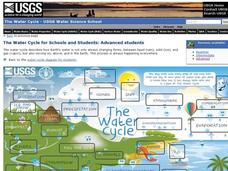Curated OER
Ants
Ants are a common example to use when conducting lessons on insects, and if your youngsters are squeamish, this is a way to introduce them without actually bringing them into the classroom! Viewers of this PowerPoint learn about the...
Curated OER
The Amazing Ant
Students explain that ants are an important element of nature's balance. Ants eat many insects and are food to other animals. They watch a video and conduct hands-on activities that give them an excellent overview of the ants role in...
Curated OER
Ant Bodies
Students name the three parts that comprise an insect body. In this ant lesson, students make connections regarding the curiosity of insects as it touches upon the students' personal perspectives. Students then observe ants in class...
Curated OER
ESL: Body Parts Vocabulary
in this ESL body parts vocabulary worksheet, learners look at pictures and choose the correct word that names each, choosing from a drop down list given, then complete a word search.
Houghton Mifflin Harcourt
Zombie Ants
One of the creepiest and coolest natural occurrences is a great forum for data analysis and discussion! Explore the phenomenon of zombie ants, or ants infected with the Cordyceps fungus, with a series of activities and experiments....
Curated OER
The Ants Go Marching
Integrate art, math, life science, music, and fun in this beginning addition and subtraction activity. Children kinesthetically represent adding and subtracting numbers to 10; they stand up one at a time as you count forward and sit down...
Curated OER
Take an Ant to Lunch
Second graders construct a model of an ant, exemplifying that ants are insects. Students gather data create a pictograph chart to show ant food preferences. Also, 2nd graders access the Internet to explore ant eating habits.
Curated OER
Larva and Adult Antlion Body Parts
Learners identify the major body segments of antlions. Through the use of diagram worksheets, students label the various body parts of the antlion. They review the life cycle of antlions from the larva stage to adult. Several activities...
Curated OER
Edible Bug Project
Students recognize the characteristics of insects. In this edible bugs activity, students observe the body parts of an insect. Students create an edible insect using a grape, carrot sticks and sorrel stems and leaves. ...
Curated OER
Ant City
Students develop an ant colony that adults and children can visit. Students create different areas including places where tourists can view live ants, play ant games, research facts about ants, and create ant art. Students serve as...
Biology Junction
World of Insects: Characteristics, Orders, and Collecting
Every bug is an insect, but not all insects are bugs. A presentation lists the characteristics of insects, describes their body parts, and explains metamorphosis. It also details every order and includes photographs and multiple facts...
Curated OER
Ants
Students listen to the story Ant Cities by Arthur Dorros, and discuss the ways that ants are similar to people. They create a butcher paper mural of an ant colony that includes hills, tunnels, rooms, grass and sky.
Nosapo
What Is in a Sentence, Paragraph, and Story?
Language arts is made up of many parts. Learners review the parts of a sentence, as well as how to make a simple sentence into a complex sentence, before examining full paragraphs and identifying the topic, body, and concluding sentence...
Curated OER
What's Bugging You?
Second graders investigate insects. In this parts of a whole, 2nd graders discuss what the three body parts of an insect are as well as the antenna. Students create their own insect labeling each body part and antenna.
Curated OER
Living in a Tree
Students explore animals that live in trees. In this nature and biology lesson, students go outdoors and make observations about animals and their unique body parts that help them to live in trees. Students create drawings as they...
Curated OER
All About Ants
Students create model ants in order to study the characteristics of insects such as body segments, number of legs, and feelers, as well as how these characteristics serve the insect.
Cornell University
Insect IPM
Find out the characteristics that makes a bug an insect with a workbook designed to inform scholars about the crawly creatures that live around us. Scholars complete an ant-themed word search, answer questions using a solution key,...
Curated OER
The World of Insects and Spiders
Students identify numerous insects and their body parts. In this insect life lesson, students practice using scientific vocabulary while comparing the different parts of spiders and insects. Students view several videos...
Curated OER
Clay Ants: Insect Anatomy
Learners examine anatomic structures in order to identify insects from other living organisms. They gain a level of comfort from anxiety when observing and handling live and pinned insects. They create clay models of an insect.
Curated OER
The Counting Caterpillar
A daily counting routine builds a caterpillar with 100 body segments (marked with symbols to indicate 2s, 5s, and 10s) by the 100th day of school. Provides structured repetition as part of the morning routine so that by 100th day,...
Curated OER
Insects
Pupils work in groups to investigate the concept of insects. They participate in a variety of activities that include the gathering of samples and making observations like identifying different body parts. The activity integrates...
Curated OER
Ask the Antlion
Young scholars observe and examine the life cycle of antlions, recording their observations of the live insects in a journal. They view an antlion on a video microscope, draw the body parts, and replicate their experiment at home.
US Geological Survey
The Water Cycle for Schools: Advanced Ages
Explore the water cycle in an interactive diagram of the process. The diagram shows how water is a moving system and constantly changing forms. The resourc includes vocabulary words that pupils click on in order to discover more about...
Curated OER
Insect Crossword Puzzle
In this insect crossword puzzle learning exercise, students complete a crossword, using clues about insect parts, habitats, physical appearance and so on.




